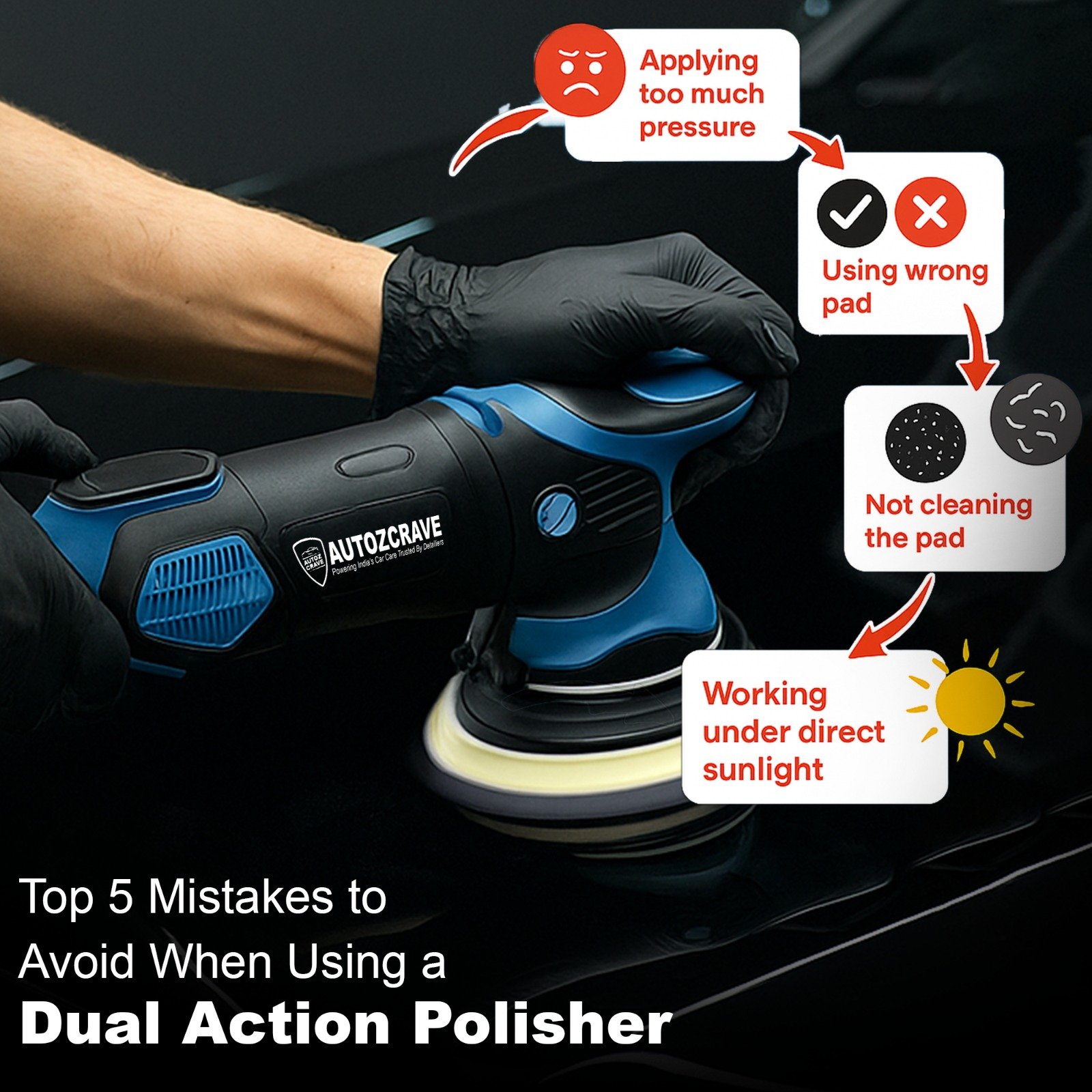Home Blog Details


Home Blog Details


Post By Autozcrave || 2025-07-23
If you run a car detailing studio or just started learning paint correction, using a dual action polisher (also called a DA polisher) can make your work faster and more professional. It's a great tool for removing swirl marks, improving shine, and correcting paint. But many detailers, especially beginners, make small mistakes that affect the final result.
In this blog, we’ll talk about the top 5 mistakes to avoid when using a dual action polisher and how you can get better results for your customers.

Before you start using a DA polisher, you must make sure the paint is clean. If there’s dust, dirt, or small particles on the surface, they can cause swirl marks during polishing. Many beginners skip this step, which leads to poor results.
What to do:
This helps avoid paint damage and gives better results with your car detailing tools.
A big mistake in polishing is using the wrong polishing pad or polish. For example, using a cutting compound with a finishing pad won’t correct the paint well. On the other hand, using a strong cutting pad with a fine polish can cause micro-marring.
What to do:
Using the right pad and compound combination is important for safe car paint correction.
Some people think that pressing harder will remove more defects. That’s not true. Applying too much pressure can stall the DA polisher, while too little pressure won’t correct the paint at all.
What to do:
This keeps your work safe and prevents dual action polisher damage risks.
Many beginners either move the machine too quickly or too slowly. If you go too fast, the polish doesn’t get time to work. If you go too slow, the area might get too hot and cause paint damage.
What to do:
With practice, you’ll get the right speed and motion to get the best shine.
After polishing a section, many people forget to check the result. Some also polish the same spot again and again, which can burn the paint or thin the clear coat.
What to do:
Smart polishing gives better results and keeps your customer’s car safe.
A DA polisher is much safer than a rotary machine. It works in a random motion, so it doesn’t create holograms or heat marks easily. It’s the best tool for swirl mark removal and giving your customer’s car a mirror like finish.
By avoiding these common mistakes with dual action polishers, you can save time, reduce rework, and improve your results.
Q1. What is a Dual Action Polisher and why is it used in car detailing?
Answer:
A dual action polisher is a machine used for car paint correction, removing swirl marks, light scratches, and oxidation. It’s called "dual action" because it rotates and oscillates at the same time, making it safe for beginners and professionals.
Q2. Can a DA polisher damage the car’s paint?
Answer:
Yes, if used the wrong way. Applying too much pressure or staying in one spot too long can cause heat and damage the paint. However, with the right technique, it’s one of the safest car detailing tools.
Q3. What are the most common mistakes beginners make with a DA polisher?
Answer:
Some DA polisher mistakes include not cleaning the surface, using the wrong pad, pressing too hard, or polishing too fast. These mistakes can cause poor results or even paint damage.
Q4. What kind of pads should I use with a dual action polisher?
Answer:
Use different polishing pads for different tasks:
Match the pad with the right polish or compound.
Q5. How much pressure should I apply while polishing?
Answer:
Apply light to medium pressure. Pressing too hard can stall the DA polisher or overheat the paint. Let the machine do the work with steady hand control.
Q6. How fast should I move the DA polisher across the panel?
Answer:
Move the machine slowly – about 1 inch per second. If you move too fast, the polish won’t work properly. Going too slow may cause overheating.
Q7. Why do I still see swirl marks after polishing with a DA polisher?
Answer:
There could be many reasons:
Q8. Should I polish every car that comes into my detailing studio?
Answer:
No, not every car needs polishing. Check the paint condition. If there are scratches, dullness, or swirl marks, then polish. Over-polishing can wear down the clear coat.
Q9. Can I use a DA polisher on plastic or rubber parts?
Answer:
Avoid using it on plastic or rubber trims. It can leave white stains or burn marks. Always tape off delicate areas before polishing.
Q10. What is the difference between a dual action polisher and a rotary polisher?
Answer:
A DA polisher is safer and easier to control, ideal for beginners. A rotary polisher spins in a single direction and is more aggressive, suitable for advanced users.